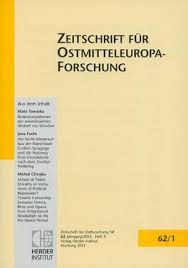Zwischen Selbstreflexion und Projektion. Die Bilder von Ostjuden in zionistischen und orthodoxen deutsch-jüdischen Periodika während des Ersten Weltkriegs
Between Self-Reflection and Projection – The Images of Ostjuden in Zionist and Orthodox German-Jewish Periodicals During the First World War
Author(s): Sarah PanterSubject(s): Communication studies, Politics and communication, Pre-WW I & WW I (1900 -1919), History of Antisemitism
Published by: Verlag Herder-Institut
Keywords: Self-Reflection; Projection; Images of Ostjuden; Zionist and Orthodox German-Jewish Periodicals; First World War;
Summary/Abstract: Until today, the First World War represents a neglected aspect in Jewish history and historiography – even though the war itself hardly left a Jewish community unaffected. One effect of the war was the tremendous suffering of Jewish civilians in Eastern Europe. Another effect, especially for German Jews, was the encounter with East European Jews, or as the stereotype was termed, the Ostjuden. Many German-Jewish soldiers who served at the eastern front were now able to experience the life of the Jewish masses in the East firsthand. Before that many German Jews were oftentimes only familiar with Eastern Jews through anecdotes and descriptions. Contrary to many studies focusing on the liberal current within German Jewry, this essay concentrates on the images of East European Jews within the Zionist and orthodox currents. This analysis thus asks in what way the images of East European Jews that were created by these two currents, served as a projection screen and a mirror for self-reflections of own identity constructions. While the discourse about Ostjuden had already existed before the outbreak and continued after the end of the First World War, the war itself, the developments abroad and at home, increasing anti-Semitism and fear of immigration of Ostjuden, but also a fascination with the authenticity of the Ostjude, could serve as a catalyzer of the discourse about Ostjuden. Hence, while stereotypes are usually conceived to be negative, the sources analyzed in this essay display existing positive stereotypes as well.
Journal: Zeitschrift für Ostmitteleuropa-Forschung
- Issue Year: 59/2010
- Issue No: 1
- Page Range: 65-92
- Page Count: 28
- Language: German

